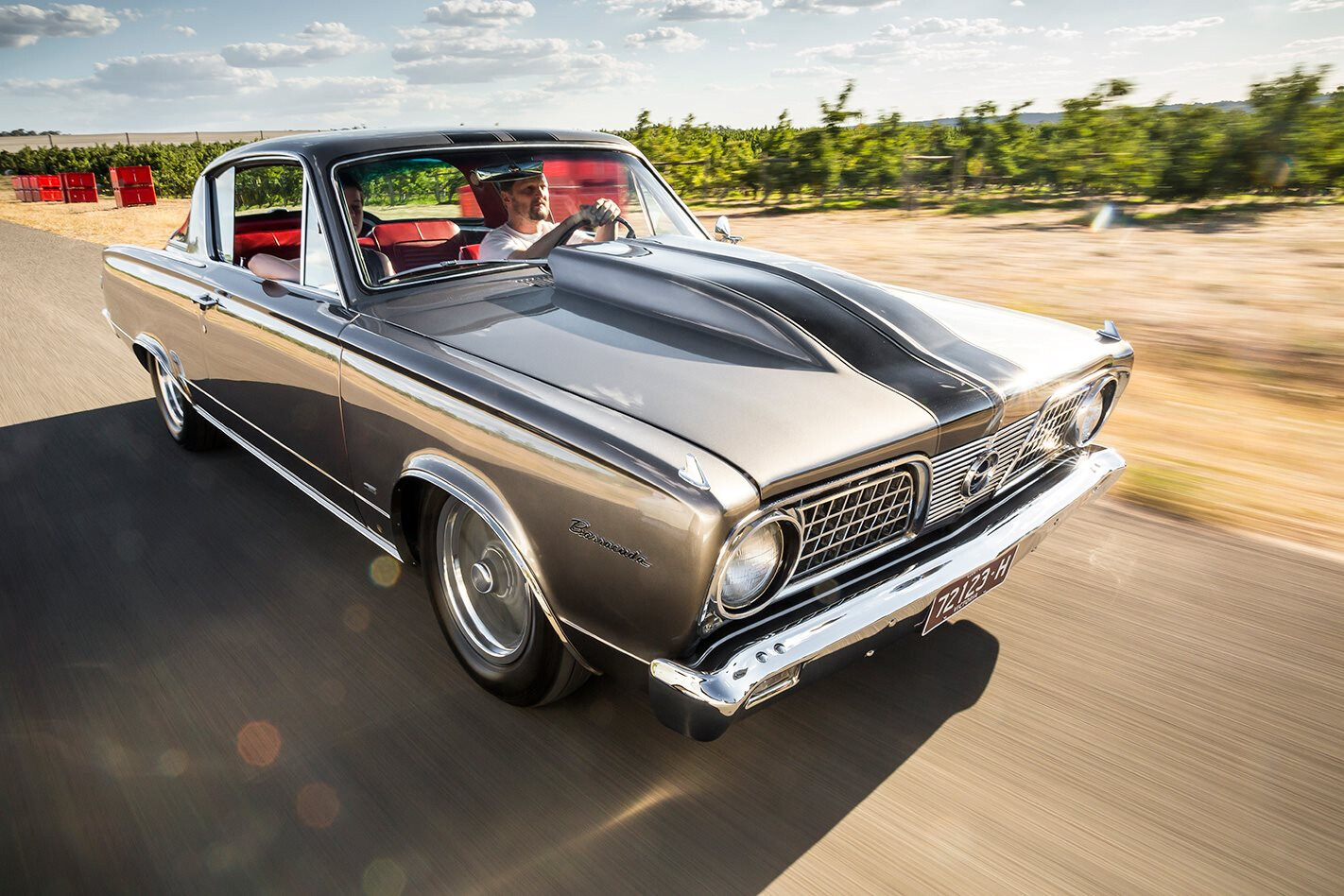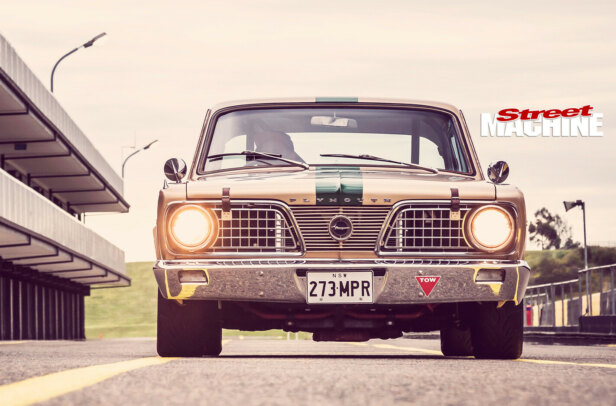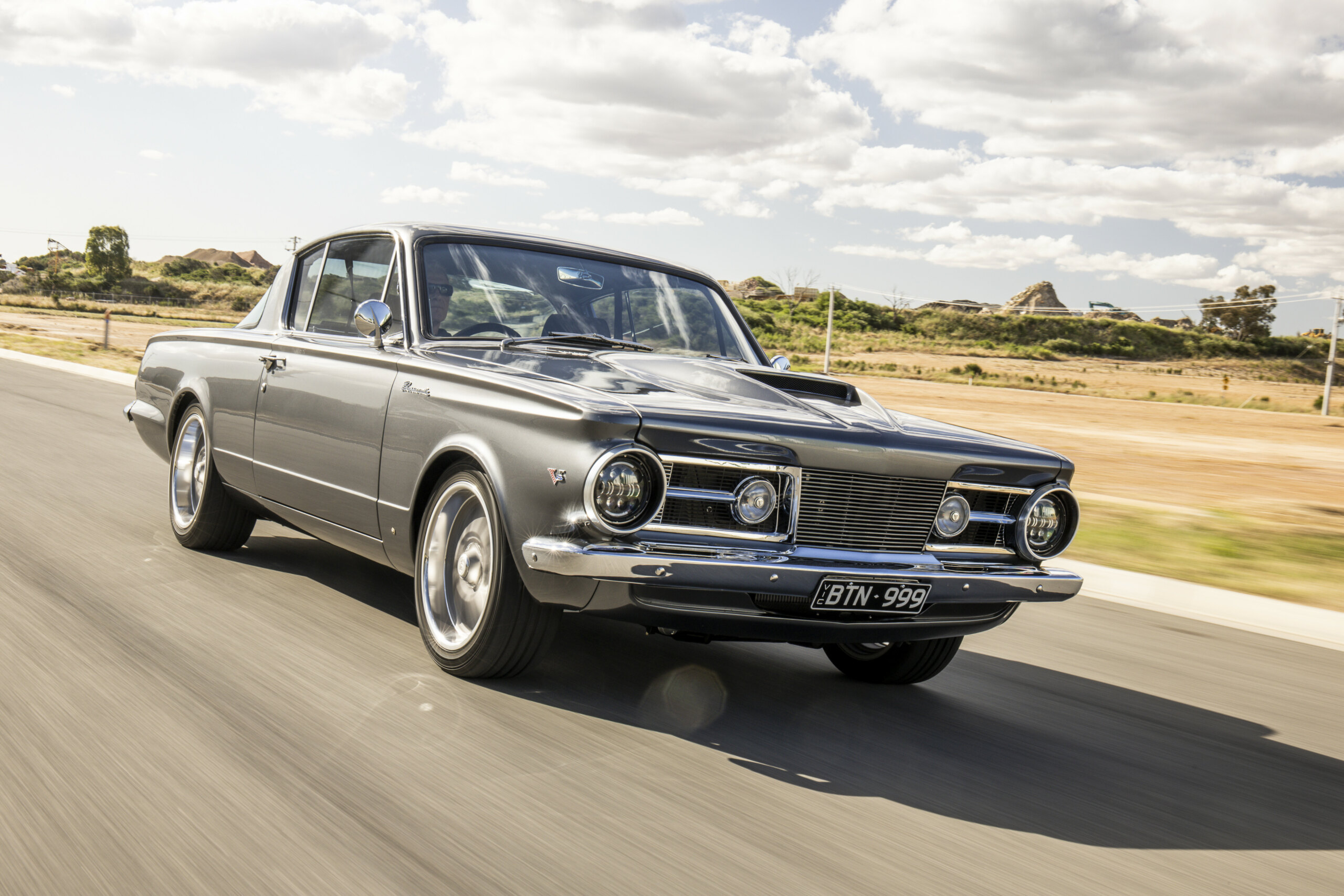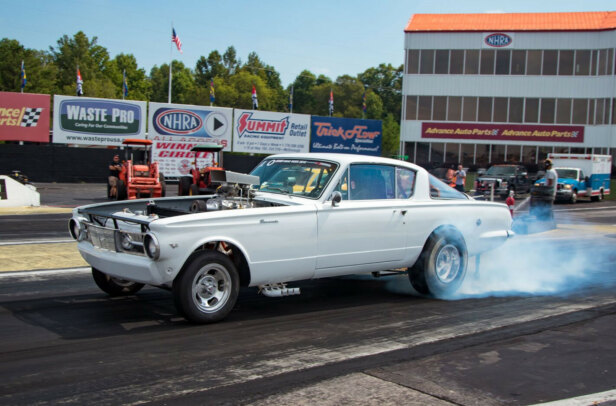I LOVE stories about people building cars who manage to just duck and weave the challenges and take it all in their stride.
This article on Glenn’s 1966 Plymouth Barracuda was originally published in the July 2017 issue of Street Machine
This willingness to get out and have a crack impresses the shit out of me, especially when they employ homespun ingenuity and any means at their disposal. Case in point is Glenn Rewell and the build of his 1966 Plymouth Barracuda.
Check the pics – is the paint of the quality you’d expect from a backyard spray booth? How about the interior; would you have thought that YouTube was instrumental in Glenn completing the trim? I think not.
The Barracuda was a sharp-looking car for the ‘sports’ compact market back in the 60s. Based on the US Plymouth Valiant platform and using shared sheet metal and trim, it was a budget muscle option for the family man looking to keep some lead in his pencil. The resemblance to our Aussie VC Valiant is clear too. Glenn laid down the Liquid Metal hue and stripes himself, and both nicely accentuate the crisp lines of this bodystyle. Combined with a tough stance, reverse-cowl scoop and gasser-inspired wheels, Glenn has created his own interpretation of what a hot Barracuda streeter should be.
Okay, this may not be Glenn’s first skid around the block – he has an impressive fleet to his credit that includes a chopped Dodge hot rod, a blown ’69 Camaro and a new HQ project on the go – but his tough-arsed Barracuda employed a healthy dose of the ways and means act to see it built to an impressive standard and affordable budget.
For starters, as a classy two-door option the first-generation Barracuda makes a great choice. The distinctive wraparound rear glass of these early Yankee A-bodies is iconic, and both the first incarnation (think our AP-series Valiants) and its subsequent facelift (in line with our home-turf VCs) were used as foundation platforms for the legendary and appropriately named Hemi Under Glass wheelstander.
“I was looking for a cheap two-door car to use as a driver and spotted this ’66 in South Australia,” Glenn says. “I thought it was a cool-looking car and loved its shape and their history; did you know that rear ’screen was the largest piece of glass ever made for a production car?
It hadn’t been in the country long and was advertised for the right price, so I struck a deal and it was on its way home. “It was pretty much as advertised, with no initial surprises; the interior was stuffed and the headlining was missing, but it drove well and the paint and panel looked okay.
”The clean-up started with the body, and within two weeks the ‘okay’ exterior had become a completely stripped shell sitting in Glenn’s garage. The paint was nicely hiding plenty of rust, so Glenn got to work making patch panels for the doors, lower front guards, rear quarter panels and boot lid, while any superfluous holes in the engine bay were filled.
With a four-inch reverse-cowl grafted on and the remaining bodywork sorted, Glenn cobbled together a plastic-drop-sheet spray booth and laid down the Glasurit grey hue dubbed Liquid Metal. The stripes were then masked and painted before the whole kit and caboodle was lathered in clear.
The greenhouse-spec rear ’screen is a piece of styling genius from an era when design flair and brand individuality had yet to be quashed by economic factors and safety compliance. “I took that rear window out by myself,” Glenn remembers. “I cut the sealing rubber, crouched in the boot area with my back against the glass, then stood up to break it free and grabbed both sides. I walked it down using a step ladder, looking like a turtle. I was as nervous as hell about breaking it”
With the body and engine bay looking schmick, Glenn got busy with the mechanicals. As the owner of Rewell’s Mower Service in Castlemaine, he was probably relieved to work on more than one cylinder at a time, so he stripped the 273-cube small-block bare and reassembled it with fresh internals.
A 273 is a grunty little number in stock form, and even more so when paired to a lightweight early A-body. However, Glenn was keen to add more punch to match the Barracuda’s visuals, so a Summit hydraulic cam was fitted along with home-ported heads, topped by a Holley Strip Dominator intake and 600cfm Holley carb.
The factory 273 donk is a torquey and often-underrated little powerpack, but Glenn chose to add more punch to his ’66 via a sensible cam, carb and manifolds combo, all nestled in a neat and subtly detailed engine bay. A three-speed manual trans and nine-inch diff round out the driveline
Block-hugger headers were sourced simply enough via eBay, although fitting one of this pair was a different matter altogether, with Glenn having to wield his fab skills and scratch-build some new straws for the driver’s side. A reconditioned original radiator was deemed fit for cooling duties, while a full complement of MSD equipment was sourced for the ignition.
The original three-speed manual transmission refreshingly remains in situ, but the column shift has made way for a Mr Gasket floor shifter, and the factory diff was swapped out – twice – for a narrowed nine-inch filled with a 3.7-geared LSD centre and 31-spline axles.
“I discovered the hard way that Mopars have the driveline offset by two inches,” Glenn chuckles ruefully. “The first housing was narrowed conventionally, which stuffed up the driveshaft angles, meaning I had to buy a second housing and have it narrowed off to one side to make it work.”
The rear end rides on relocated leaf springs, moved inboard and upwards for better right height and tyre clearance. The torsion bar front suspension was kept, albeit after a thorough overhaul. CL Valiant discs and calipers update the front end; XD Falcon drums were retained for the Ford rear.
Rolling stock is a mix of 10-spoke and salt flat designs from the Rocket Wheels catalogue, measuring in at 15x4in and 15×8.5in respectively and shod in 165/65 and 255/60 rubber.
The interior is just as impressive as the exterior, with Glenn choosing maximum bang for modest buck by compiling a full replacement trim kit through the offerings of Legendary Auto Interiors, OPGI and Classic Industries in the States, and mixing it with a healthy dose of instruction via YouTube.
“I purchased the interior when the Aussie dollar was strong,” Glenn says. “It saved heaps of time and money from trying to source it locally, especially being a less-than-common ride here on our shores. I’m a an of the original interiors too, and think they nailed the design from the factory.”
The juicy red interior was sourced from the States and was ably suited up by Glenn with some hints from YouTube. “Same goes with installing the headlining,” he says. “It’s amazing how much stuff you can learn online, and it was a pretty simple job once you saw a few tricks of the trade.” The factory-fresh finish includes a Mr Gasket Bang Shifter for the three-speed cogger and stealthily incorporated Auto Meter gauges in the original dash cluster – necessary to replace the fried originals
Glenn stripped the seats and repainted the frames and springs before refitting the new covers, and the missing hood bows were replaced with modified Fairlane items so a fresh headlining could be stretched into place.
“YouTube videos were an immense help for tackling this kind of work, and I’d recommend anyone to take the time and do some research first,” he says. “I found the video tuition easy to follow and the fitment is bang-on factory for a neat result.”
The dash restoration is more of Glenn’s handiwork, using a mix of coarse metallic paint and chrome pinstriping tape to restore the major bling, while the gauges are aftermarket items modified for a factory appearance. “I went to test the original gauges and they went up in smoke,” Glenn says.
“I bought the half-sweep Auto Meter versions in matching diameters, then ground off the bezels and painted the needles a more suitable colour before using homemade brackets to mount them into their original slots. Tacho aside, the dash looks stock, which is the finish I was chasing.”
The Barracuda has clocked up around 2000 trouble-free kays, with many more on the cards, and even scooped a few trophies at a couple of local shows. “I just love cars and enjoy tackling all sorts of car-related challenges,” Glenn enthuses.
“My son Jackson and I do pretty much everything involved for a project at home, and it’s nice to have finished cars like the Barracuda to drive and enjoy while we’re building the HQ. We’ve already mini-tubbed it, relocated the suspension mounts, stepped the front chassis rails and raised the rear floor, so it’s pretty in-depth.”
I’m sure the monthly YouTube data is copping a flogging with mods like that on the go, so I’m offering up a name for this HQ nice and early: Q-Tube.
Come on Glenn, you know you want to!
GLENN REWELL
1966 PLYMOUTH BARRACUDA
Paint: Glasurit Liquid Metal
DONK
Engine: Chrysler 273ci
Block: Factory cast
Intake: Holley Strip Dominator
Carbs: Edelbrock 600cfm
Heads: Cast, ported & polished
Cam: Summit hydraulic; 272 duration, .454in lift
Ignition: MSD coil, distributor & leads
SHIFT
Transmission: Three- speed manual
Diff: 9in, 3.7 gears, 31-spline axles
BENEATH
Front: Factory torsion bar
Rear: Relocated leaf spring Shocks: Gabriel (f), Summit (r)
Brakes: CL Valiant discs (f), XD Falcon drums (r)
ROLLING STOCK
Rims: Rocket Racing; 15×4 (f), 15×8.5 (r)
Tyres: 165/65 (f), 255/60 (r)




Comments